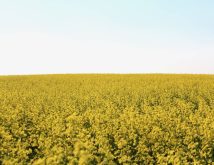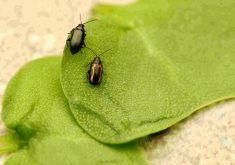Few farmers track stand density after the combine rolls, but the Canola Council of Canada says those are the numbers that really count.
“That’s going to give you your absolute measure of success,” Gregory Sekulic, agronomy specialist with the council, said. “When you’re talking about seed mortality, we quite commonly see in excess of 50 per cent mortality in Canadian fields and, when seeding rates are reduced, we see that number increase.”
Most farmers, however, still count solely in the spring, numbers that Sekulic warns may lead to overestimating crop density when it comes to how many plants survive to fill seed.
Read Also

Manitoba data in on Maizex canola hybrids
Maizex Seeds has two new canola hybrids for western Canadian farmers to plant for the 2026 crop. The latest Manitoba trial data is in on the new varieties.
The Canola Council of Canada puts the ideal stand at five to seven plants per square foot at harvest, according to the CanoLAB speaker, while the same area should yield seven to 10 plants in spring.
“Canola crops need 50 plants per square metre (five per square foot) to maintain yield potential. Plant populations lower than this will almost always have yield loss,” the council’s website states.
The council estimates stands with five to six plants a square foot yield five bushels more an acre than those with two to three plants.
“We lose a lot of things once they come out of the ground… a little bit of interplant competition is certainly possible, especially in higher plant stands,” Sekulic said. “Frost events, wind events, hail events, insect events, all these things can subtract away from that.”
The council’s research draws on both spring and fall counts when establishing links between density and yield potential, this year’s CanoLAB attendees in Brandon and Dauphin heard March 14-15.
So do spring counts matter?
First counts will still give farmers a baseline and should be done, Sekulic stressed. Each plant becomes more critical as stands thin, and initial density may impact fungicide decisions and other steps to keep plant loss down.
Research out of Alberta has had good results when running lower densities through economic analysis, Sekulic acknowledged, although Manitoba experts had concerns with how well those results would translate in the field.
Murray Hartman, Alberta Agriculture and Forestry oilseed specialist and a presenter at field events in Manitoba last summer, put the ideal range closer to four to six plants a square foot during the season.
“The actual, physical response of yield to density now is different with the herbicide-tolerant hybrids. We can achieve high yield with fewer plants than we used to,” he said at the time, pointing to the higher cost of hybrid seed.
Critics from Manitoba Agriculture, however, worried that lower density would lower weed competition, putting more stress on herbicides.
Uniformity also plays into yield potential, CanoLAB attendees heard. Sekulic presented field data suggesting that five plants per square foot can yield as much as eight plants per square foot if the less dense field is uniform and the higher-density field is patchy.
The agronomy specialist suggested that farmers boost their target stand numbers if their field starts coming up patchy.
















